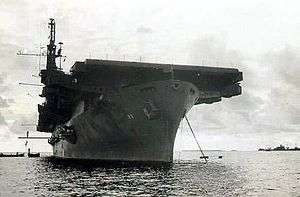USS Bismarck Sea (CVE-95)
 | |
| History | |
|---|---|
| Name: | USS Bismarck Sea |
| Builder: | Kaiser Shipyards |
| Laid down: | 31 January 1944 |
| Launched: | 17 April 1944 |
| Commissioned: | 20 May 1944 |
| Fate: | Sunk by kamikazes[1] during the Battle of Iwo Jima on 21 February 1945 |
| General characteristics | |
| Class and type: | Casablanca-class escort carrier |
| Displacement: |
|
| Length: | 512 ft 3 in (156.13 m) overall |
| Beam: |
|
| Draft: | 22 ft 6 in (6.86 m) |
| Propulsion: |
|
| Speed: | 19 knots (35 km/h) |
| Range: | 10,240 nmi (18,960 km) at 15 kn (28 km/h) |
| Complement: | 923 |
| Armament: |
|
| Aircraft carried: | 27 |
| Service record | |
| Part of: | United States Pacific Fleet (1944-1945) |
| Operations: | |
| Awards: | 3 Battle stars |
USS Bismarck Sea (CVE-95) was a Casablanca class escort carrier of the United States Navy. She was launched on 17 April 1944 by Kaiser Co., Inc., Vancouver, Washington, under a Maritime Commission contract as Alikula Bay; sponsored by Mrs. M. C. Wallgren, wife of Senator Monrad Wallgren; renamed Bismarck Sea on 16 May 1944; transferred to the Navy on 20 May 1944; and commissioned the same day, with Captain J. L. Pratt in command.
Service history
During July and August 1944, Bismarck Sea escorted convoys between San Diego, California, and the Marshall Islands. After repairs and additional training at San Diego, she steamed to Ulithi, Caroline Islands, to join Admiral Thomas C. Kinkaid's 7th Fleet. During 14–23 November 1944, she operated off Leyte in support of the operations and later took part in the Lingayen Gulf landings (9–18 January 1945). On 16 February, she arrived off Iwo Jima to support the invasion.
On 21 February 1945, despite heavy gunfire, two Japanese kamikazes hit the Bismarck Sea, first on the starboard side under the first 40 mm gun (aft), crashing through the hangar deck and striking the ship's magazines. The fire was nearly under control when the second plane struck the aft elevator shaft, exploding on impact and destroying the fire fighting salt water distribution system, thus preventing any further damage control. Shortly after, the order was given to abandon ship. The USS Bismarck Sea sank with the loss of 318 men, and was the last US Navy aircraft carrier to be lost during World War II.[2] Three destroyers and three destroyer escorts rescued survivors over the next 12 hours, between them saving a total of 605 officers and men from her crew of 923. Survivors were then transferred to Dickens and Highlands.
According to the Dictionary of American Naval Fighting Ships, USS Edmonds directed the rescue operations of the remaining hands, saving 378 of the carrier's crew including the commanding officer, in spite of darkness, heavy seas and continuing air attacks. Thirty of Edmonds' own crew went over the side to bring the wounded and exhausted carrier men to safety.
Awards
Bismarck Sea received three battle stars for her World War II operations.
See also
References
External links
| Wikimedia Commons has media related to USS Bismarck Sea (CVE-95). |
- Battle of Iwo Jima
- Narrative by: Captain John L. Pratt, USN Sinking of the USS BISMARCK SEA off Iwo Jima.
This article incorporates text from the public domain Dictionary of American Naval Fighting Ships.
Coordinates: 24°2′21″N 141°18′49″E / 24.03917°N 141.31361°E